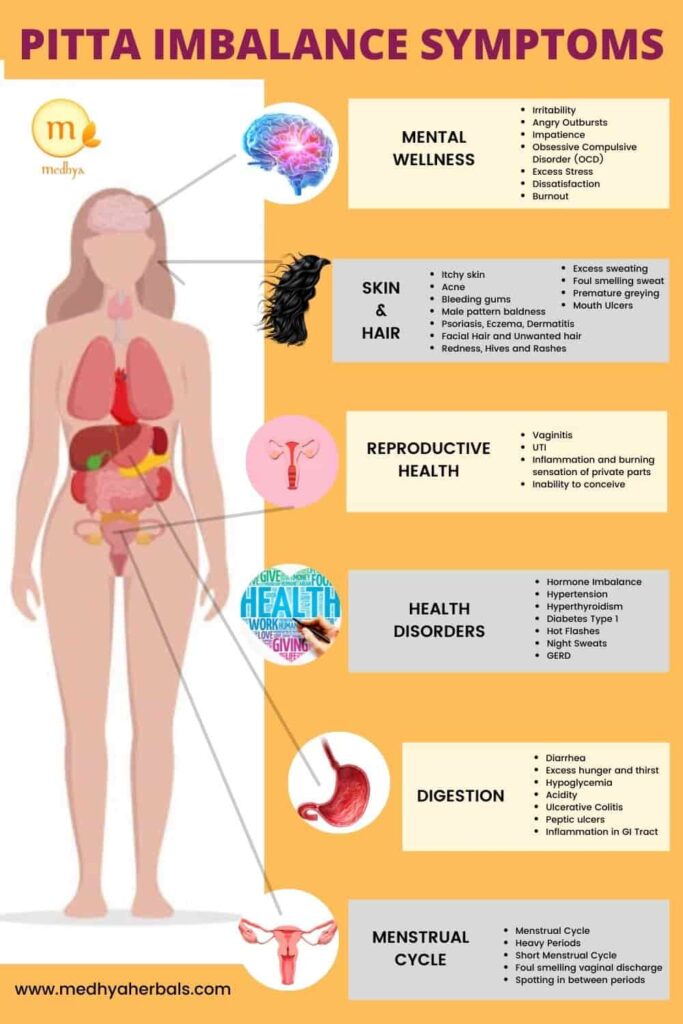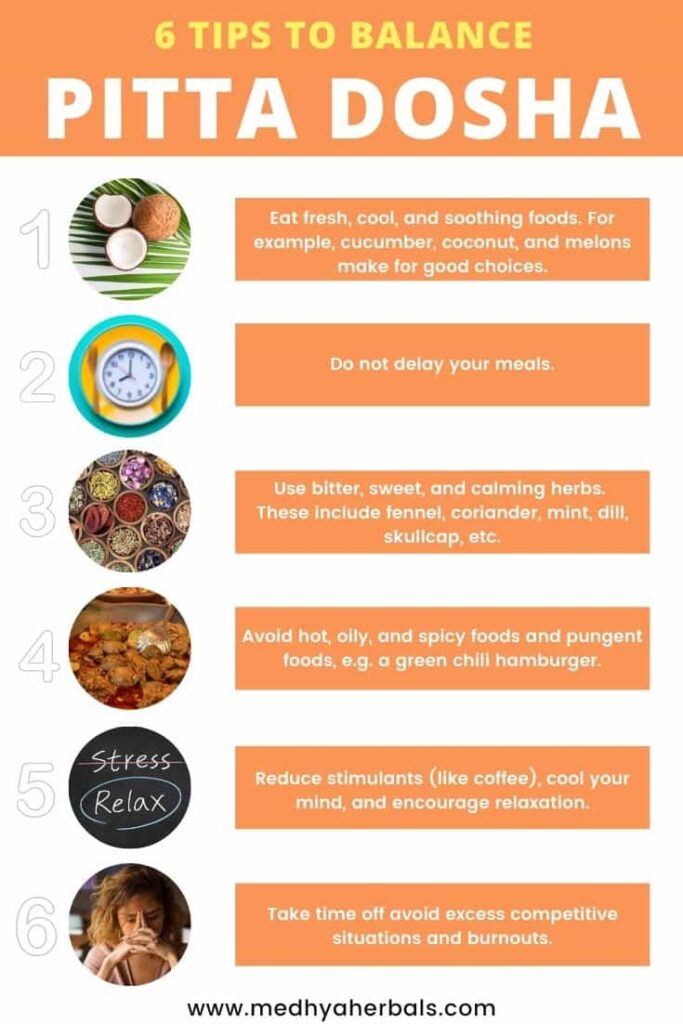Pitta Dosha is the energy of metabolism and transformation. That’s why Pitta Imbalance creates high heat and metabolic health issues in the body.
Symptoms of Pitta Imbalance appear as burning sensation, pricking pain, redness, and heat in different body parts.
Usually Pitta increases under hunger, pressing deadlines and in summer season.
High Pitta level triggers inflammation, blood impurities, hyper acidity, and severe hot flashes. Pitta imbalance leads to irritation, anger, and intensity of emotions at the mental level.
In this post you will learn about the causes and symptoms of pitta imbalance. We will also look into pitta dosha pacifying diet, yoga and lifestyle routine to balance your health in the Ayurvedic way!
1. Symptoms of Pitta Imbalance in the Mind
- Pitta Imbalance or Increase is exhibited with the emotions of intolerance – irritability, anger, impatience, judgment, criticism, and jealousy. One becomes intolerant to their own self and to others.
- High levels of Pitta can also lead to a tendency toward perfectionism, Obsessive Compulsive Disorder (OCD), burnout from excessive work, dissatisfaction, and lack of content.
- Low pitta can also lead one to stay caught in their own imaginary perfect world and stage of denial. It leads to lack of decisiveness and action.
2. Health Issues of Pitta Imbalance in Women
- Inflammation, burning sensation, and pain in the reproductive organs.
- Endometriosis, excessive bleeding during menstruation, heavy and prolonged periods, and spotting in between the periods.
- Hyperthyroidism
- Leucorrhea with foul smelling vaginal discharge that is often persistent and yellowish in colour.
- Hot Flashes, Migraine, extreme irritability, and angry outbursts may be observed during life stages of transition such as Menopause, Menstruation, and Pregnancy.
- Vaginitis and frequent urinary tract infections.
- Tenderness and pain the breasts.
- Heart palpitations, hypertension, and increased risk of heart stroke.

3. Health Issues of Pitta Imbalance in Men
- High pitta can cause inflammation in the reproductive system. This can lead to health disorders such as epididymitis.
- Pitta aggravation can lead to burning pain during ejaculation.
- Hormonal imbalances
4. Pitta Imbalance leads to Hyperacidity, Peptic Ulcers and Gallstones
- Early signs of pitta increase include a sense of insatiability that is marked by intense hunger and excessive thirst.
- Pitta accumulation and aggravation leads to nausea, vomiting, hiccups, acid reflux, heartburn, hyperacidity, GERD, loose stools, and diarrhea.
- “Tikshnagni” or high digestive fire leads to low blood sugar, irritability, anger, and dizziness before the meals or a strong urge to eat between the meals.
- Yellowish coating is observed on the tongue with sour or bitter taste in the mouth. The breath, stools, sweat, and menstrual bleeding becomes foul smelling with Pitta increase.
- Excessive pitta leads to formation of lumps in the bile juice that accumulate in gall bladder as gallstones.
- Peptic ulcers, ulcerative colitis, leaky gut, and inflammation of GI tract is often observed in Pitta increase.
5. Pitta Imbalance leads to Skin Rashes, Premature Greying of Hair and Baldness
- High levels of pitta is marked by impurity and heat in the blood. Hence, pitta increase can trigger redness, heat, hives, rashes, acne, eczema, psoriasis, and dermatitis in the skin.
- Pitta imbalance leads to easy bruises and burns on the skin internally and externally. Bleeding gums, canker sores, or mouth ulcers can be triggered by pitta increase.
- Excessive sweating is observed. Strong, acidic, and fleshy-smelling body odor are caused by pitta imbalance.
- Pitta imbalanace loosens the hair follicles at the root and hence baldness is observed.
- Pitta Imbalance leads to premature greying of the hair on the scalp. Extreme cases can have greying of hair throughout their bodies.
6. Pitta Imbalance leads to an Incomplete Digestion and High Appetite
An individual with Pitta Dosha Imbalance suffers from an overactive digestive system and very high digestive fire. This leads to an unusual levels of hunger, excessive thirst, acidity, and an incomplete digestion of the foods.
In Ayurveda, Pitta type of digestion is called Tikshna Agni
An incomplete digestion leads to nutritional deficiencies and related health problems even if a person is consuming healthy foods.
Medhya Herbals
Hence, it is important to balance the digestive fire first, before one dives into good foods or bad foods for Pitta Dosha balance.

What are the primary causes for Pitta Imbalance?
Pitta Dosha aggravation can happen in anybody, whether they are primarily Pitta-Dosha and also in case Vata or Kapha Dosha is their prime governing energies.
The basic principle of Dosha governance is that like increases like. It means that there are high chances for pitta aggravation if one is exposed to excessive hot temperatures on the prolonged basis, or intakes excessive hot natured, spicy, and fried foods. Some triggers to increase Pitta are:
1. Kala – Time of the Day, Season, and Your Age affect Pitta Balance
- Pitta Dosha is aggravated in the summer season, from May till July in the Indian continent. Hence, one gets prone to health disorders related to acidity, inflammation, headaches, insatiability.
- Pitta imbalance is more common in middle age group. However, extended periods of mental stress and exposure to chemicals leads to pitta imbalance in younger and older age groups as well.
- During the day, Pitta Dosha is active from 10 AM to 2 PM and from 10 PM to 2 AM. This is the time when Pitta health disorders will show their symptoms to be slightly aggravated. For example, one would find rashes, inflammation, acidity, or heart problems build up.
2. Ahara – Food and Dietary Habits that cause Pitta Imbalance
- Regular consumption of hot, spicy, and fried food items.
- Excessive consumption of salty, sour, and fermented foods.
- Holding off hunger for prolonged periods.
- Inability to slow down and consumption of food while performing other activities such as work, entertainment, driving, or walking.
3. Vihara – Lifestyle Practices that cause Pitta Imbalance
- Sudden, excessive, or prolonged exposure to hot temperature and damp environment.
- Stressful environment, excessive work, and tight timelines.
- Excessive physical or mental activity that leads to burnout.
- Excessive screen time during the day, inability to take breaks or relax, and prolonged work hours till sleeping.
- Bright lights and exposure to excessively hot and bright sun.
4. Vichara – Mental State that leads to Pitta Imbalance
- High level of competition and a tendency to always push the limits.
- Excessively pressing timelines and activities when conducted on regular basis.
- Excessive stress due to work or relationships.
- Multi-tasking or multiple pressing projects.

What is Pitta Dosha Balance?
A balanced Pitta Dosha is exhibited with excellent stamina, good physique, immunity to diseases, and a stable emotional state.
- Balanced pitta has good levels of comprehension, passion, compassion, and mental clarity.
- A balanced pitta individual usually takes up leadership roles within an organisation or social circle. They act as the change makers and motivate the lot behind them.
- Pitta Dosha’s essential characteristics are metabolism and transformation. It is marked by good digestion level, optimum hunger, and absence of addiction or cravings.
- Regular one to two time bowel movement with smooth stool elimination
- Regular menstruation with 3 – 5 days of menstrual cycle and normal bleeding.
- Balanced hormones, enzyme secretions, and neurotransmitter levels.
- Good stamina and endurance. Ability to undergo moderate level physical activity and extreme mental challenges without much health impact.
- Radiant skin, bright shiny eyes, and lustrous hair.
Ayurvedic Tips for Pitta Dosha Balance
To balance Pitta Dosha, once should practice a lifestyle that would relax, cool down, and calm both mental and physical body system. Pitta Diet and Lifestyle involves moderation, surrender, and relaxation are most effective for Pitta balance.
Pitta Pacifying Diet – Foods, Herbs and Dietary Habits
- Include a variety of fresh vegetables in both raw and cooked form. Go for Astringent, Sweet, and Bitter tastes.
- Eat in a calm and relaxed setting. Do not work while eating and do not rush through the meals.
- Prefer cooling Ayurvedic Herbs and spices such as Rose, Cardamom, Cinnamon, Lemon Grass, and Coriander to eliminate excess pitta.
- Oils to prefer are Ghee, Olive Oil, and Coconut Oil.
- Take salads in moderation during lunch time or in the morning.
- Prefer cooling and normal temperature beverages such as coconut water, still water, and herbal teas.
- One should not skip meals or avoid food when hungry.
- Do not overeat! Do not take food when you are not hungry. Follow this guide to 10 Ayurvedic Dietary Habits for Metabolism.
- Eliminate foods with a hot potency and hot temperature such as chilli and cayenne pepper.
- Remove and avoid caffeine, alcohol, and nicotine.
Lifestyle Practices for Pitta Balance
- Self-massage or Abhyanga with cooling and heavy oils such as Coconut Oil, Olive oil, or Ghee is cooling, relaxing, and grounding for pitta. Apply oil to your scalp and soles on daily basis. Perform full body massage on weekly basis.
- Slow down, enjoy, and relax. Be in the moment and do things for the sole purpose of joy rather than productivity.
- Avoid intense heat, hot temperatures, and excessive exposure to the hot midday Sun.
- Leave the perfectionist attitude. Be willing to make mistakes yourself.
- Regular meditation with a focus on breathing to calm down the mind.
Physical Activity to Balance Pitta Dosha
Pitta usually has high level of motivation and competitive spirit. Hence, pitta individuals and pitta imbalance should always try to push the limits and do everything in excess.
- Pitta benefit the most through regular, relaxing, calming, and cooling physical activity.
- Exercise at least 3 – 5 days a week through stabilising workout routines such as involving in recreational and non-competitive sports, traditional dances, swimming, hiking, running or brisk walking in nature or near water, yoga, Tai Chi, or Cycling.
- Physical activity should be avoided in warm temperatures as it will aggravate pitta. Prefer cooling temperatures of early morning or late evening.
- Avoid over exertion and excessive stretch. It aggravates Pitta and leaves no room to recharge or calm down. As a golden rule, exercise up to 50% of your body’s capacity.
- Adopt new and dynamic routines that can help to channel and satisfy your pitta energy to learn new skills or sports.
Yoga Poses for Pitta Imbalance
Pitta imbalance benefits from yoga sequences that involve flexibility, slow easy movement, and stillness.
Pitta should hold a pose till there is no strain and no heat is created. Yoga sequences that are gentle, calming, and cooling to the body and mind are highly beneficial to balance Pitta.
Inversion yoga poses are contraindicated during menstrual cycle and during pregnancy.
- Bhujangasana – Cobra Pose
- Janu Sirsasana – Head to Knee Pose
- Parsva Upavistha Konasana – Over One Open Leg Forward Bend Pose
- Paschimottanasana – Full Forward Bend
- Kurmasana – Tortoise Pose
- Makarasana – Locust Variation
- Urdhva Dhanurasana – Upward Bow Pose
- Surya Namaskar – Sun Salutation
- Jathara Parivartanasana – Revolving Stomach Twist
- Balasana – Child’s Pose
- Dipada Pidam – Bridge Pose
Pranayama | Breathing Exercises for Pitta Imbalance
Pranayama practices involve breathing exercises, which develop the life-force in the body. It promotes flow of energy, awaken the mind, and cleanse the body.
Pranayama increases Agni, promotes heat, and increases flow of vital force of Prana through the body.
Following Pranayama techniques are recommended for Pitta Dosha balance:
- Shitali Pranayama and Sitkari Pranayama
- Ujjayi Pranayama – Breath of Victory
- Left Nostril Breathing
Read here to know about Vata Imbalance and Kapha Imbalance.
Now we would like to hear from you. Have you tried any of the above Ayurvedic guidelines to balance Pitta Dosha? What worked for you and what was your experience? Do let us in the comments below.
Or if you have any queries. Ping us here and we’ll get back the soonest. Wishing you vibrant health!
References
- Textbook fo Ayurveda – Part 1 by Vasant Lad
- Yoga for your body type by Dr. David Frawley and Sandra Summerfield Kozak


I am an 83 year old male, who is in the 1st stages of CKD. While I am very active and have been on a Vegan diet and over all feel like I'm in my 50s, it is my goal to feel even better. About 12 years ago I had a stroke. I was diagnose with type 2 diabetes, high blood pressure
and A-fib. However through my diet and some exercise I have reduced my blood sugar levels to as low as 5.9 and my blood pressure to
some where between 128/82 to 140/75. however having said all that I as earlier stated want to do even better.My MD and Kidney doctor
seemed please with my results, but I know that Western Medicine, is not cure all, and the is why I believe Ayurveda herbs can help me.
I would appreciate hearing from you to let me know wether you honestly believe you can help me to achieve my health goals.
Thank you in advance,
Fred Burnell (Mr Music}
Hello! Sure, we can help you out to improve your health, BP and blood sugar levels with Ayurveda. Please look here to take appointment with our Ayurvedic Doctors, who can tailor your health protocol per your specific requirements. https://medhyaherbals.com/ayurvedic-treatment/